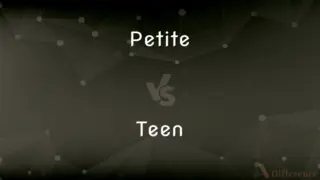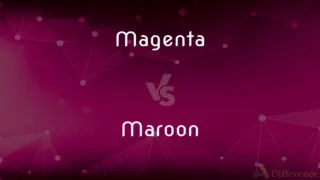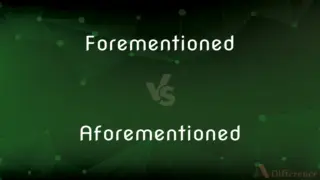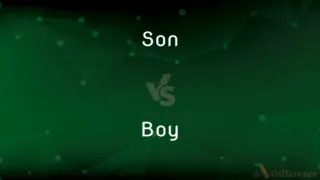Plastid vs. Chloroplast — What's the Difference?
By Tayyaba Rehman & Maham Liaqat — Updated on March 19, 2024
Plastids are a diverse group of organelles in plant cells, while chloroplasts are a specific type of plastid involved in photosynthesis.
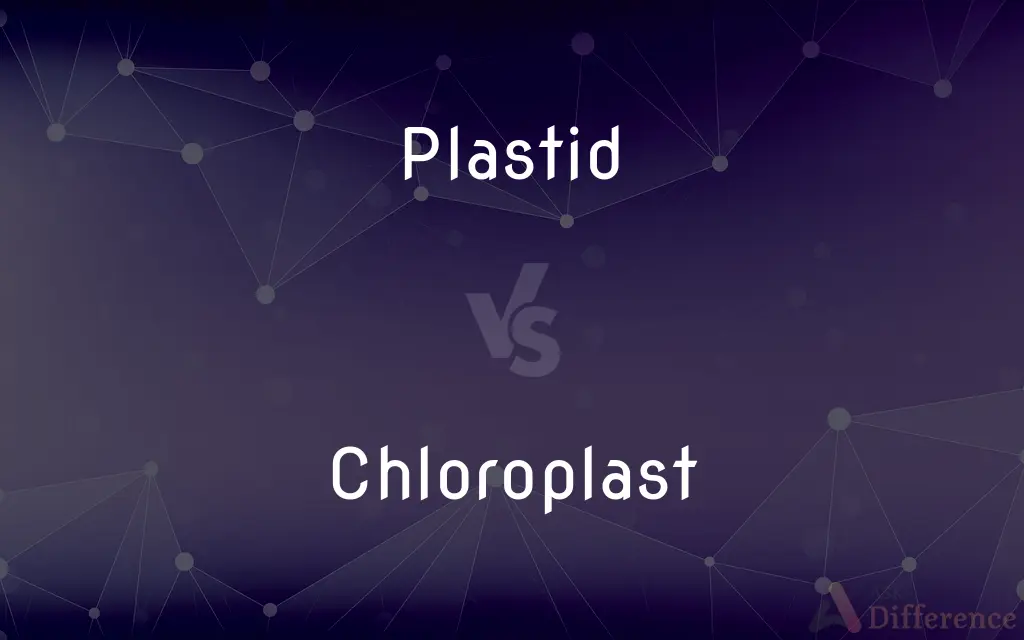
Difference Between Plastid and Chloroplast
Table of Contents
ADVERTISEMENT
Key Differences
Plastids are versatile organelles found in the cells of plants and algae, serving various functions like storage and pigmentation. Whereas, chloroplasts are a specialized type of plastid that contain chlorophyll and are essential for the process of photosynthesis, converting light energy into chemical energy.
While all chloroplasts are plastids, not all plastids are chloroplasts. Plastids can differentiate into several types, including chloroplasts for photosynthesis, chromoplasts for pigment synthesis and storage, and leucoplasts for the storage of starch, oils, and proteins. On the other hand, chloroplasts are specifically designed for capturing light energy and converting it into sugars through photosynthesis.
Plastids have the unique ability to differentiate into various forms based on the cell's needs, environmental conditions, or developmental stage. Chloroplasts, in contrast, maintain a specific function centered around photosynthesis and are characterized by their green color due to the presence of chlorophyll.
In terms of structure, plastids generally have a double membrane envelope, but their internal structure can vary significantly. Chloroplasts are distinct in having an additional internal membrane system called thylakoids, which are stacked into structures known as grana where photosynthesis primarily occurs.
The evolutionary origin of plastids is traced back to a single endosymbiotic event where a eukaryotic cell engulfed a photosynthetic cyanobacterium. Chloroplasts specifically are believed to have evolved from these ancestral photosynthetic bacteria, adapting and diversifying within different plant and algal lineages.
ADVERTISEMENT
Comparison Chart
Definition
A group of organelles in plant and algal cells with various functions.
A specific type of plastid that performs photosynthesis.
Types
Includes chloroplasts, chromoplasts, leucoplasts, etc.
A subtype of plastids specialized for photosynthesis.
Function
Varies: photosynthesis, storage, pigmentation.
Specifically for photosynthesis, converting light energy to chemical energy.
Structure
Generally double membrane-bound; structure varies by type.
Contains thylakoids and grana within the double membrane.
Pigments
Can contain different pigments based on type (chlorophyll, carotenoids, etc.).
Primarily contains chlorophyll, giving them a green color.
Compare with Definitions
Plastid
A diverse group of organelles in plant and algal cells with various functions.
A chromoplast gives color to ripe tomatoes.
Chloroplast
A specific type of plastid that contains chlorophyll and is involved in photosynthesis.
Chloroplasts in plant leaves capture sunlight.
Plastid
Can differentiate into various types including chloroplasts, chromoplasts, and leucoplasts.
Amyloplasts in potatoes store starch.
Chloroplast
Contains thylakoids stacked into grana, surrounded by a double membrane.
The thylakoids in chloroplasts are where light reactions occur.
Plastid
General structure includes a double membrane, with internal structures varying by type.
Leucoplasts lack pigments and have a simple structure.
Chloroplast
Converts light energy into chemical energy through photosynthesis.
Chloroplasts synthesize glucose as a food source for the plant.
Plastid
Their functions range from photosynthesis to storage and pigmentation.
Chloroplasts in leaves are involved in photosynthesis.
Chloroplast
Characterized by their green color due to chlorophyll.
The green color of leaves is due to the chlorophyll in chloroplasts.
Plastid
Evolved from an endosymbiotic relationship with cyanobacteria.
The diversity of plastids reflects their evolutionary adaptability.
Chloroplast
Essential for photosynthesis, providing energy and oxygen.
Chloroplasts are crucial for the growth and health of plants.
Plastid
Any of several cytoplasmic organelles, such as chloroplasts, that contain genetic material, have a double membrane, and are often pigmented. Plastids are found in plants, algae, and certain other eukaryotic organisms and have various physiological functions, such as the synthesis and storage of food.
Chloroplast
A plastid that contains chlorophyll and is found in the cells of green plants and algae.
Plastid
(cytology) Any of various organelles found in the cells of plants and algae, often concerned with photosynthesis
Chloroplast
(cytology) An organelle, found in the cells of green plants and in photosynthetic algae, where photosynthesis takes place, characterized by a high concentration of chlorophyll and two membranes.
Plastid
The plastid (Greek: πλαστός; plastós: formed, molded – plural plastids) is a membrane-bound organelle found in the cells of plants, algae, and some other eukaryotic organisms. They are considered to be intracellular endosymbiotic Cyanobacteria.
Chloroplast
Chloroplasts are organelles that conduct photosynthesis, where the photosynthetic pigment chlorophyll captures the energy from sunlight, converts it, and stores it in the energy-storage molecules ATP and NADPH while freeing oxygen from water in plant and algal cells. They then use the ATP and NADPH to make organic molecules from carbon dioxide in a process known as the Calvin cycle.
Plastid
A formative particle of albuminous matter; a monad; a cytode. See the Note under Morphon.
Chloroplast
A plastid containing chlorophyll, developed only in cells exposed to the light. Chloroplasts are minute flattened granules, usually occurring in great numbers in the cytoplasm near the cell wall, and consist of a colorless ground substance saturated with chlorophyll pigments. Under light of varying intensity they exhibit phototactic movements. In animals chloroplasts occur only in certain low forms.
Plastid
Any of several types of minute granules found in the protoplasm of vegetable cells, having their own membrane, robosomes, and DNA. Among plant cells the most common are chloroplasts, which contain the chlorophyll and the photosynthetic machinery of the cell. They are divided by their colors into three classes, chloroplastids, chromoplastids, and leucoplastids.
Chloroplast
Plastid containing chlorophyll and other pigments; in plants that carry out photosynthesis
Plastid
Any of various small particles in the cytoplasm of the cells of plants and some animals containing pigments or starch or oil or protein
Common Curiosities
Can plastids change their function?
Yes, plastids have the ability to differentiate into different types based on the cell's needs, environmental conditions, or developmental stages.
Why are chloroplasts green?
Chloroplasts are green due to the presence of chlorophyll, a pigment that captures light energy for photosynthesis.
What are plastids?
Plastids are a group of organelles in plant and algal cells that serve a variety of functions, including photosynthesis, storage, and pigmentation.
What is the primary function of chloroplasts?
Chloroplasts are specialized for photosynthesis, converting light energy into chemical energy in the form of glucose.
Are all plastids involved in photosynthesis?
No, only chloroplasts are specifically involved in photosynthesis. Other plastids, like chromoplasts and leucoplasts, have different functions.
How do chloroplasts contribute to plant growth?
Chloroplasts synthesize glucose through photosynthesis, providing energy for growth and releasing oxygen as a by-product.
What is the evolutionary origin of plastids?
Plastids originated from a symbiotic relationship between a eukaryotic host cell and a photosynthetic cyanobacterium.
How do environmental factors affect plastid functions?
Environmental factors like light, temperature, and nutrients can influence plastid differentiation, pigment synthesis, and storage capabilities.
Can plastids be found in non-plant organisms?
Plastids are primarily found in plants and algae, but some protists also contain plastids acquired through secondary or tertiary endosymbiotic events.
Can the number of chloroplasts in a cell change?
Yes, the number of chloroplasts can change depending on environmental conditions, such as light intensity.
How are leucoplasts different from chloroplasts?
Leucoplasts are colorless plastids specialized for the storage of starch, oils, or proteins, unlike chloroplasts which are involved in photosynthesis.
What is the significance of plastid diversity in plants?
Plastid diversity allows plants to adapt to various environmental conditions, optimize energy production, and perform specific functions like pigmentation and storage.
How do chloroplasts and mitochondria differ in energy production?
Chloroplasts convert light energy into chemical energy through photosynthesis, while mitochondria generate ATP through cellular respiration.
Why is photosynthesis important for life on Earth?
Photosynthesis is crucial for producing oxygen and organic compounds, serving as the foundation of most food chains.
What role do chromoplasts play in plants?
Chromoplasts synthesize and store pigments like carotenoids, contributing to the coloration of fruits, flowers, and leaves.
Share Your Discovery
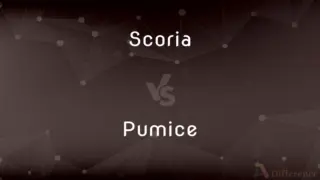
Previous Comparison
Scoria vs. Pumice
Next Comparison
Samurai vs. NinjaAuthor Spotlight
Written by
Tayyaba RehmanTayyaba Rehman is a distinguished writer, currently serving as a primary contributor to askdifference.com. As a researcher in semantics and etymology, Tayyaba's passion for the complexity of languages and their distinctions has found a perfect home on the platform. Tayyaba delves into the intricacies of language, distinguishing between commonly confused words and phrases, thereby providing clarity for readers worldwide.
Co-written by
Maham Liaqat




